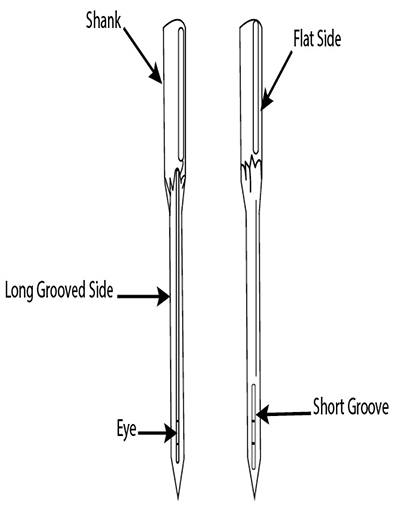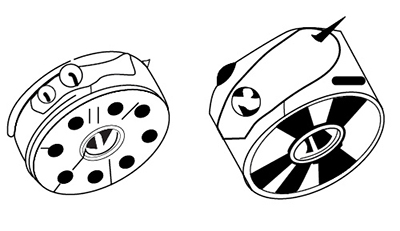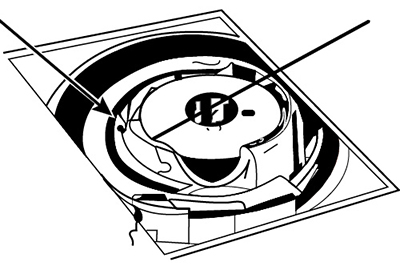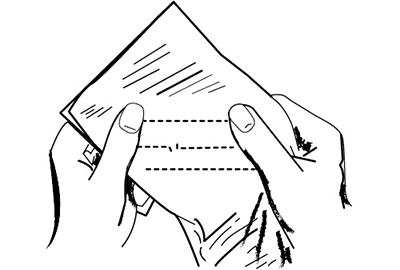Sewing Machine Maintenance
Guide C-102
Revised by Wendy Hamilton
College of Agricultural, Consumer and Environmental Sciences, New Mexico State University
Author: Professor and CES Grants and Contracts Development Specialist, Media Productions Department, New Mexico State University. (Print friendly PDF)
Introduction
A well-made sewing machine—traditional or serger, new or old, used often or only occasionally—will sew perfectly for many years if it is given proper care. It may need to be adjusted or a part may need to be replaced, but a sewing machine that is given proper maintenance and cleaned regularly seldom actually “wears out.”
Sewing machines generally require basic maintenance of cleaning, oiling, and lubricating. These procedures are covered in the use and care booklet that comes with the machine. It is the best reference for the specific care required by your machine. Some machines are designed to be oil- and lubricant-free, so follow the directions in your booklet carefully.
If you do not have an instruction booklet for your sewing machine, contact your local sewing machine center to obtain one. If they do not have one in stock, write to the manufacturer of the machine to obtain one or go online to download and print a copy. Be sure to have handy the machine name, model, serial number, and approximate age of the machine.
Getting at the Problem
When you have trouble with your sewing machine, a good rule to follow is “clean it first.” Many problems are caused by dust, lint, or thread ends that have collected on the working parts of the machine.
Simply brushing lint and dust from the machine each time it is used is a good way to prevent many problems. Use the soft nylon brush that comes with the machine or a narrow paint brush to dust away lint in the bobbin case, under the needle plate, and around the feed dog. A needle or tweezers can be used to remove pieces of thread or lint that cannot be brushed away. Canned pressurized air can also be used to blow dust and lint away.
In time, lint and dust that are allowed to accumulate in a sewing machine can become soaked with oil and/or lubricant and interfere with the operation of the machine. When this gummy grime is removed, the machine will work more freely, and adjustment may not be necessary. Removing this unwanted buildup requires more care and time than everyday maintenance.
The following procedures do not apply to all electric machines–specifically those with bearings packed in grease and chain-stitch machines. They do apply to older models of electric lock-stitch machines and treadle machines. Check your machine instruction booklet to determine the procedure recommended to clean it, then use this guide along with your booklet.
Supplies and Equipment
You need the following equipment and supplies for the job:
- Pie or cake pan for soaking parts in cleaning fluid
- Small screwdriver
- Large screwdriver
- Small adjustable wrench
- Hammer (optional)
- Small oil can (clean) for cleaning fluid
- Cleaning brush (narrow, nylon)
- Paring knife (or pocket knife)
- Long needle or small crochet hook
- Tweezers
- Cleaning cloths
- Fabric to test stitching
- Can of sewing machine oil (check your machine
instruction booklet for the type recommended) - Tube of sewing machine lubricant (check your machine instruction booklet for the type recommended)
- Small bottle or can of cleaning solvent that will not flash flame at temperatures below 120°F. It is usually available at gasoline stations or cleaning establishments. Never use gasoline; it is highly flammable. Never use carbon tetrachloride; it is very poisonous.
- Newspapers
- Plastic wrap (household type)
- Rubber gloves
- Magnifying glass (optional)
- Flashlight (optional)
After assembling all supplies and equipment, unplug and move the machine to a cleaning area that is well lit. Protect the floor and table top with newspapers. A good floor or table lamp to light the work area from over your shoulder will be helpful. A flashlight is also helpful for adding light in hard-to-see areas.
General Cleaning
As you clean the machine, it is best to clean one area at a time. Remove only the parts that are involved and be sure to note where each part is from, its position, and which side is top (Figure 1).

Figure 1. Remove all the parts possible in order to clean the machine thoroughly. Keep the parts in order to make it easier to replace them.
When removing parts, remember that “left is loose and right is tight” on practically all screws and bolts. When using a screwdriver, put the pressure on the push, not on the twist. If a screw will not loosen easily, soak it with cleaning fluid. Then set the screwdriver in the slot and tap sharply with a hammer before attempting to loosen. The screwdriver blade should be as wide as the slot in the screw is long. Always use a wrench—not pliers—on bolts.
First, remove the needle, presser foot, slide plate, throat plate, bobbin case, and the face plate (if it comes off; Figure 2). Put them in a pan and cover with cleaning fluid. Set aside to soak while cleaning other areas.

Figure 2. Bobbin area. If possible, remove the bobbin case to remove all lint and stray threads.
Next, wrap the motor (if necessary) and wire with plastic wrap to protect them from oil and cleaning solvent. Be sure the machine has been unplugged!
Now, it is time to begin work to clean the machine head. With a sharp pointed tool, clean out all oil holes. Then, with your hand, turn the handwheel to run the machine. At the same time, squirt cleaning fluid into all the oil holes, on all bearings, and on all other places where one part rubs against or turns within another.
If the machine begins to run hard, it is a sign that dirt or lint has jammed inside a bearing. Continue running the machine and flushing with cleaning fluid until the dirt and gummed oil are washed from the bearing. When the machine runs easily again, tip the head and flush the parts underneath the machine—all oil holes, bearings, and places that rub against or within one another. Continue running the machine by hand until it functions smoothly.
To remove any remaining dirt and oil, dip a cloth or brush in cleaning fluid and scrub all parts of the machine that can be reached. Use a needle, knife, or other pointed instrument to dig or scrape away any remaining gummed dirt or lint in the feed dog, around the bobbin case, and in other areas.
Check the lower tension of the bobbin case and the upper thread tension discs. Pull a thread under the tension of the bobbin to remove dirt. Pull a piece of cloth soaked in cleaning fluid back and forth between the discs of the upper tension (Figure 3). Repeat with a dry cloth to be sure no lint or thread is caught between them.

Figure 3. Upper thread tension. Pull a piece of cloth soaked in solvent back and forth between the discs to clean.
Areas Needing Attention
In addition to general cleaning, three areas need special attention: the handwheel bearing and the clutch assembly, the needle bar and presser foot, and the hook and bobbin area assemblies. When the handwheel assembly gets gummy and dirty, it must be cleaned for the clutch to work properly. The clutch disengages the needle bar when winding a bobbin.
Some newer sewing machines refill the bobbin in its regular position and a clutch is not necessary. In such machines, it is often not necessary to remove the handwheel to clean this area.
Bobbin and Hook Area
Lint is the primary offender in this area. The bobbin case can be removed on all makes of machines. Use a dry brush to clean out all lint (Figure 4). Remove any thread that may be wound up around the hook shaft. On many machines, the hook assembly can also be removed for more complete cleaning. Place one drop of oil on the exterior perimeter of the hook and the bobbin race (the ledge that the hook sits on) to lubricate it after cleaning.

Figure 4. Bobbin area. Clean carefully to remove lint using a soft brush. Tweezers may be helpful in removing stray threads.
Face Plate Area
The face plate on most machines is held in place with one or two screws. By removing these, the plate can be easily removed for cleaning both the needle and presser foot bars. On some newer machines, the face plate is a part of a housing that is mounted on hinges, which makes it easy to move the entire housing away from the bars and mechanisms behind it. No other parts need to be removed for cleaning in this area. First use a dry brush to clean out all lint and other foreign material (Figure 5). A small piece of cloth with a little solvent on it can be used to clean the needle bar and presser bar of any gummy grease.

Figure 5. Face plate area. Remove lint from the face plate area using a soft brush. A cloth dipped in solvent can be used to remove grease and grime.
After thoroughly cleaning, place a drop or two of oil on each shaft where it slides through the housing (Figure 6). Oil all other moving parts according to your instruction book before replacing the face plate.

Figure 6. Face plate area. Place a drop or two of oil on moving parts where they slide through a housing or move against each other.
Handwheel Area
To remove the clutch and handwheel, loosen the small screw in the face of the locknut (the locknut is the part that is turned to the left to release the clutch for operating the bobbin winder; Figure 7). Next, unscrew the locknut and remove the washer and handwheel. Most machines will have a washer that looks like one of the three shown (Figure 8). Some machine models will be slightly different. Notice the position of the washer so you can put it back in the same position. You may want to make a small scratch to identify the side that goes “out.”

Figure 7. Handwheel area. Loosen screw in the face of the locknut in order to remove the clutch and handwheel.

Figure 8. Different types of adjusting washers.
The handwheel should slide off the shaft easily. If the machine is driven by an external belt, this belt will have to be removed before the handwheel will come off. If the machine has an internal drive belt or the wheel obviously will not come off, do not remove the handwheel. Replace the parts you have removed and skip this area. Gear-driven machines will have a gear on the inside of the handwheel.
Clean the handwheel, washer, and shaft. Lubricate the shaft with two drops of oil and place a small amount of grease on all gears. Reassemble the handwheel and clutch. If the clutch fails to operate, either because it will not hold or fails to release, remove the locknut again and turn the washer one half turn (180°) and reassemble. The clutch should then work properly.
After thoroughly cleaning these areas, reassemble the machine and run it by hand. It should run smoothly if all parts have been replaced correctly.
Do not plug the machine in until all the cleaning fluid is dry.
Oiling and Lubricating the Machine
Allow the machine to stand overnight so excess cleaning fluid can evaporate before oiling and lubricating it. Check your machine instruction booklet to determine the type of oil lubricant to use and where to use it.
Some machines have bearings that are nylon or graphite-impregnated bronze and do not require oil or lubricant. Also, some machines do not need oiling because they are designed with oil impregnated in the bearing casings. If your machine does not require oil, do not use it.
Do not oil the tension discs, the handwheel release, or the belts and rubber rings on any machine.
In the holes designated, and on all parts that rub against or within one another, squirt a little oil (Figure 9). Run the machine by hand to distribute the oil into all the bearings. Use oil freely because all oil has been removed in the cleaning process. If there are any wool or felt pads that feed oil to parts, be sure they are well oiled.

Figure 9. Oiling. Place one or two drops of oil in all holes designated by the instruction booklet.
For later oilings, one drop of oil on each bearing and in each oil hole is enough. It is a good practice to oil the machine after each day’s work or after 8 to 10 hours of use. Even if you do not use your machine often, oil it occasionally to keep the oil from drying and gumming.
If the machine requires a lubricant, lubricate the areas suggested. Use the lubricant recommended for your machine for best results.
After oiling and lubricating the machine, wipe away excess oil and reassemble the machine. As you replace the parts that have been soaking in the pan, do not force screws or parts into place. Check to be sure each screw and part is in the correct location.
Care of the Motor
Lubricate the electric motor of your sewing machine according to the manufacturer’s directions.
Several newer machines have electric motors with sealed bearings that never need oiling. Lubricate motors that require oil or grease once a year. One or two drops per bearing is sufficient; over-oiling may ruin the motor. A sewing machine company oil or a good-quality light oil is satisfactory to use. If you select a lightweight household oil, be sure it says “non-gum forming” and “non-corrosive” on the container. On a grease-fitted bearing, fill the grease cups once a year.
Check to see that all electric connections to the motor control and motor are tight. If the cord covering is not in good condition, tape it with good-quality electrical tape or replace the cord. The belt that connects the motor to the handwheel should have just enough tension to keep it from slipping. On some machines, the belt can be adjusted by slightly shifting the position of the motor.
Take good care of the rubber driving ring or wheel on motors that drives machines by friction contact with the handwheel. If this driving ring or wheel has become flat-sided or unevenly worn, causing excessive vibration, replace it with a new one. Keep the handwheel clean and dry, and the driving ring adjusted firmly to the handwheel and in line, so the machine will run with a minimum of vibration.
Adjusting the Machine
Next, thread the machine and sew (using scraps of fabric) to test the stitching.
Needle
First, be sure the needle is the proper length. Use the needle length or number recommended in your manual.
Second, use a needle with a diameter that is suitable for the fabric and thread size you intend to sew on. Charts in your operator’s manual, in a sewing machine center, or reputable online websites give the recommended size for sewing with different thread sizes. Using a larger diameter needle results in an unattractive stitch with larger than necessary needle holes in the fabric.
Third, be sure the needle is straight and does not have a dull point or burr.
Fourth, choose needles for sewing special fabrics, such as a ballpoint needle for knits and a wedge needle for leather.
The needle should be inserted in the needle bar clamp with the long groove of the needle facing the side from which you thread the needle (Figure 10). It should be inserted all the way into the clamp until it hits the stop pin. On machines with an adjustable needle bar housing, adjust the position of the needle bar until the needle goes through the center of the needle hole in the needle plate.

Figure 10. Parts of a needle.
Needle Plate (Throat Plate)
Manufacturers of some machines recommend using the needle plate with the round hole for straight stitching and the elongated hole for the zig-zag stitch. Unless you use the proper needle plate, you may experience skipped stitches when making a straight stitch. This is especially true when sewing some synthetic fabrics. Check the needle (throat) plate for rough places and remove them with an emery paper or cloth.
Feed Dog
The teeth on the feed dog should project above the needle plate so that the bottom of the teeth, or serrations, are level with the top of the needle plate when the dog moves the material before the next stitch is made by the needle.
A good general setting is one that results in 10 to 12 stitches per inch of seam. On very thin and fine material, it may be necessary to use a shorter stitch such as 14 to 16 stitches per inch of seam. On leather or vinyl, a longer stitch may be more desirable, such as 6 to 10 stitches per inch of seam.
Presser Foot
There should be just enough pressure on the presser foot to hold the fabric on the feed dog so that a uniform length of stitch is made. As a general rule, heavy fabrics require light pressure. Pressure may be increased by pushing down on an inner pin, or decreased by releasing an outer ring. Some machines may have a thumb screw or a dial to regulate pressure. Check your machine booklet for instructions on how to adjust the presser foot of your machine.
On slippery fabrics, loosely knit fabrics, vinyl, or velvet a roller-type presser foot may produce better feeding than the standard presser foot.
When darning, either reduce the pressure on the presser foot or lower the feed dog on machines with a drop feed button, or use a cover plate.
Thread Tension
Upper and lower tension must be balanced to produce a perfect stitch. The upper tension is located differently on different machines. It may be on the face plate, on the face of the needle bar housing, on the front of the needle bar housing, or on the upper arm of the machine head.
The lower tension, located on the shuttle or bobbin case, is adjusted by a screw (Figure 11). If two screws fasten the lower tension spring to the bobbin case, adjust by turning the screw nearest the center of the spring—not the screw on the end.


Figure 11. Lower tension adjustment screw on bobbin.
If, during the cleaning, the lower tension spring has been removed or its adjustment changed, the adjusting procedure is the same as in the ordinary use of the machine. That is, assume the lower tension to be correct until proved wrong. Make all adjustments on the upper tension first.
If the lower tension has been disturbed, set both lower and upper tension so there will be a slight drag on each thread. Use the same size thread on both bobbin and spool. After adjusting the tension, take a look at the stitching the machine makes. To help you to see the stitches clearly, use contrasting colors of thread on the spool and in the bobbin. Set the stitch-length control for a medium stitch length. Fold a 6- to 8-inch square of sheeting or average weight cloth and stitch diagonally across it at an angle of about 45°.
Now inspect the stitching (Figure 12). In a perfect stitch, threads are locked in the center, midway between the two layers of cloth, with no loops on the top or bottom of the seam and no puckers in the cloth (Figure 13).

Figure 12. Inspecting test stitching on a piece of cloth.

Figure 13. Perfectly locked stitch.
If loops of the bobbin thread show on the top side of the seam and the top thread is straight, the upper tension is tighter than the lower. In this case, loosen the top tension (Figure 14).

Figure 14. Upper tension too tight.
If loops of the spool thread show on the underside of the seam and the lower thread is straight, the upper tension is looser than the lower and should be tightened (Figure 15).

Figure 15. Upper tension too loose.
Operating Tips
- Always be sure the machine is oiled and properly threaded, and that the bobbin is lint-free before starting to sew.
- Use a needle size suitable for the fabric and thread weight. Be sure the needle is the correct length, straight, and sharp. Change needles frequently when sewing synthetic fabrics. Ballpoint needles help prevent damage to knit fabrics.
- Use the same thread in the bobbin as on the spool unless you are creating a special effect.
- Pull the bobbin thread through the needle hole in the needle plate before starting to stitch.
- As you start to stitch, place both threads under the presser foot and hold them to the back of the machine.
- Turn the handwheel toward you to start the stitching, if needed.
- Start and stop the machine with the needle and thread take-up lever in their highest position.
- Once the tension on the upper thread and bobbin thread are balanced, change only the upper thread tension for slight variation, as needed.
- To turn a corner, stop the machine while the needle is still in the fabric. Raise the presser foot and turn the fabric, using the needle as a pivot point. Then lower the presser foot and resume sewing.
- Protect your clean sewing from machine dust and grime between sewing projects by covering it or putting it inside the sewing cabinet or machine case.
Portions of this guide were adapted from Holbrook, H.S., and A.V. Krewatch. 1943. Sewing machines: Cleaning and adjusting [Farmers’ bulletin no. 1944]. Washington, D.C.: U.S. Department of Agriculture.
For Further Reading
C-202: Checklist of Common Sewing Machine Problems
https://pubs.nmsu.edu/_c/C202/
C-203: Buying a Sewing Machine
https://pubs.nmsu.edu/_c/C203/
C-213: Free-motion Machine Embroidery
https://pubs.nmsu.edu/_c/C213/

Wendy Hamilton is an Extension Evaluation and Accountability Specialist at New Mexico State University who provides expertise for program development and evaluation. She has worked at four land-grant universities, and has a diverse background in textiles and clothing, adult education, 4-H youth-at-risk, horticulture, evaluation, and grant writing.
To find more resources for your business, home, or family, visit the College of Agricultural, Consumer and Environmental Sciences on the World Wide Web at pubs.nmsu.edu
Contents of publications may be freely reproduced for educational purposes. All other rights reserved. For permission to use publications for other purposes, contact pubs@nmsu.edu or the authors listed on the publication.
New Mexico State University is an equal opportunity/affirmative action employer and educator. NMSU and the U.S. Department of Agriculture cooperating.
Revised January 2017


